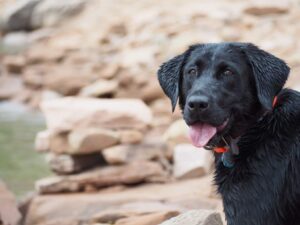Leashes are an incredibly important tool for making sure dogs and people stay safe in the modern world. However, they can be a hinderance at times – and many handlers would love for their dogs to be reliable off-leash!
There are three essential skills that every dog should have before going off-leash:
- Recall (coming when called)
- Stay
- Leave It & Drop It
The most important skill your dog must have is the ability to perform any of those three essential safety skills in any environment, regardless of the distraction.
Recall
This is the most obvious essential skill, and by far the most important. When your dog is off-leash, they are using their judgement to navigate the environment. You need to be able to get them out of any situation they may be putting themselves in. You also need to be able to take physical control of them at any time, in case of an emergency. Here are some real-life situations that recall has saved one of my dogs:
- Your dog is running towards a busy road
- Your dog is frolicking in the woods, running towards a steep drop-off
- Your dog is busy sniffing and exploring, and does not notice an approaching moose
- Your dog is running towards a half-frozen lake, intending to jump in
Stay
This is a less obvious safety skill, and not quite as important as a recall. After you recall your dog, you can regain physical control of them if you have a collar or leash on hand (which you should bring even on off-leash adventures!) There are many situations in which you may be unable to physically control your dog, or in which it would be unsafe to tether your dog to you. There are also situations in which you need to gain control of your dog, but recalling would put them into more danger.
- Your dog has crossed a road and is unaware of the danger. Recalling would put them in the path of traffic.
- Your dog is some distance away, and you have stumbled upon a moose or other large game. Recalling would aggravate the wildlife, and potentially trigger a charge or attack.
- Your dog has successfully recalled away from some danger, but the leash or collar is unusable or missing.
- Your dog has successfully recalled away from some danger, but you are injured or unable to hold a leash.
- You are navigating unknown terrain and need your dog to wait while you ensure the path ahead is safe.
Leave It & Drop It
Dogs do not always make decisions that align with our preferences when it comes to interacting with objects in the world. Whether you are in an urban environment dodging chicken bones and garbage, or traipsing through a forest with coyote poop and long-dead deer carcasses, there will always be things our dogs want to engage with that we would prefer they avoid.
“Leave it” ensures that if you see your dog get curious about something nasty or dangerous, you can quickly direct them away from it (although a recall can work in a pinch!) This can also come in handy with prey-driven dogs to direct them to give up the chase.
“Drop it” ensures that if your dog finds something “fun” when they’re out of sight, they can easily be directed to spit their treasure out and leave it behind.
Proofing: The Most Important Skill
All of these behaviors are completely worthless if your dog isn’t able to do them in any environment, at any level of distraction, and at any distance from you. If your dog is not 100% reliable on-leash with all of these behaviors in all situations, then they are not ready to be off-leash. The leash serves as your back-up plan & safety net for when your training fails. Going off-leash before you and your dog are prepared can make your dog reliant on their leash and drastically damage their suitability for off-leash ability.



